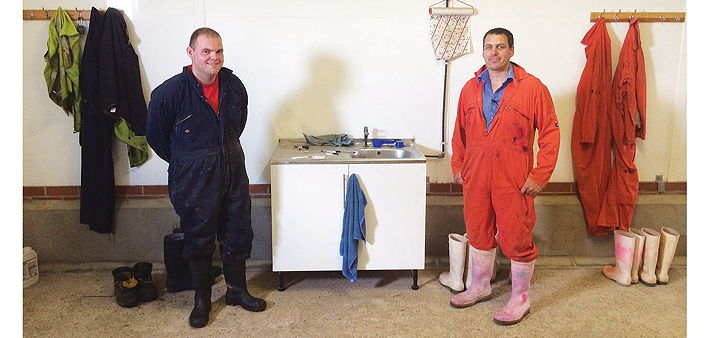In the second part of our three-part series exploring the steps producers can take to prevent disease from infecting and spreading throughout a site, or to other units, we visit East Yorkshire pig producer Ed Rowbottom, who has a “colourful” approach to biosecurity – simple and effective, and yet currently still rare in the GB industry
With a three-stage finishing system, with nursery pigs, growers and finishers all located on one site, Ed Rowbottom considers his system unusual compared to most pig units. In the nursery building alone, there are 2,000 pigs weighing between 7kg and 22kg housed in six rooms.
“With so many young, susceptible pigs under one roof, it’s vital that we implement strict biosecurity measures to stop any disease entering or spreading within the building,” he says. “We believe that if you protect the pigs at this early stage, you’ll reap the rewards later on in the production cycle.”
The farm has implemented robust biosecurity during the growing cycle.
“At the heart of our approach is a straightforward clothing colour-coding system,” Mr Rowbottom (pictured above, right) says. “It’s an incredibly simple yet effective approach that we’ve implemented for the past 10 years, yet it remains a rare concept in the British pig industry.
“I believe its success is down to its simplicity. For instance, it’s easy to overlook using a potentially contaminated needle, yet if you’re seen in a unit in the wrong coloured footwear it’s instantly recognisable by the entire team.”
At the time of the system’s creation, the unit was having issues with an E coli scour outbreak in the growers and finishers, however, it wasn’t being seen in the nursery building.
“That’s what prompted us to implement the colour-coding system,” Mr Rowbottom says. “We believed that reducing direct contact among the three production stages would reduce the spread of disease.
“So, from that point forwards, before entering the nursery unit, everyone has to remove the blue overalls and green wellies that they’ve been wearing in the grower and finisher buildings, wash their hands thoroughly and change to a pair of orange overalls and white wellies that are located on the other side of a sink. Once this process is complete, they’re free to enter the nursery unit.
“On exiting the building, everyone has to carry out the same procedure in reverse.”
Mr Rowbottom highlights that this is a process that works effectively when managed well, but acknowledges it does require additional costs associated with purchasing and washing the overalls. This, however, is minimal compared to the cost that a serious disease outbreak could bring.
“We’re certain that these procedures have helped us successfully manage the spread of disease and see no reason to alter what’s working,” he says. “All of our staff are on board with the concept. However, I appreciate that if introduced on other units it would require careful planning and the provision of adequate resources.
“To encourage uptake and successful implementation, producers need to clearly explain the theory behind the process to help staff stick to it long-term.”
AHDB Pork’s technical veterinary team manager, Martin Smith, wants to encourage more producers to implement the colour-coding systems on their units.
“What Mr Rowbottom’s doing on his unit isn’t anything new,” he says, “however, it’s clearly working well and I’d encourage other producers to consider it for use on their own sites.
“It’s important to note that every unit is different and, for this reason, the system may require tweaking to ensure that it’s tailored correctly. There may also be some structural work required to get buildings to a suitable standard. For example, Mr Rowbottom had to plumb a sink into his nursery building so that staff could wash their hands before putting on the clean overalls.
“I appreciate that there might be an initial investment cost, but in the long-term it’s definitely worthwhile and the results that Mr Rowbottom has seen are proof that it works.”
As part of his ongoing biosecurity strategy, Mr Rowbottom is also planning to reduce the access to his unit.
“Whether its people, animals or vehicles, reducing access to the unit is something high on our priority list to improve biosecurity,” he says. “We want to become better at monitoring the flow of people and vehicles onto and off the unit.
“For this reason, we’re looking to seal up some access points so we only have two entrances; we’re also going to look to increase the height of the wall surrounding the site.
“We believe this is an important next step for us in terms of biosecurity, and with the threat of emerging diseases increasing, it’s something we’ll implement soon.”
For more information on protecting pig health, CLICK HERE
For the first part in this series CLICK HERE




